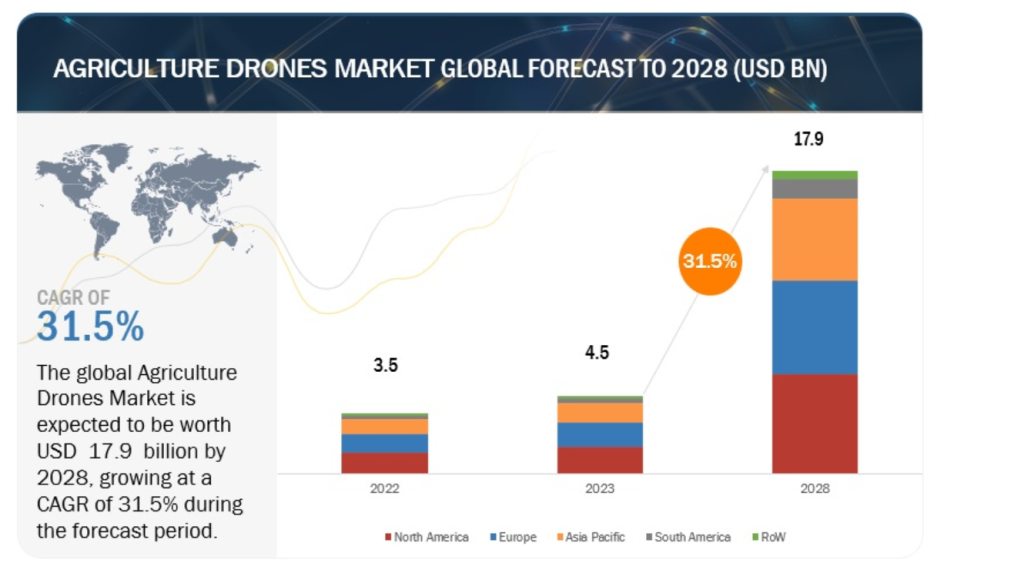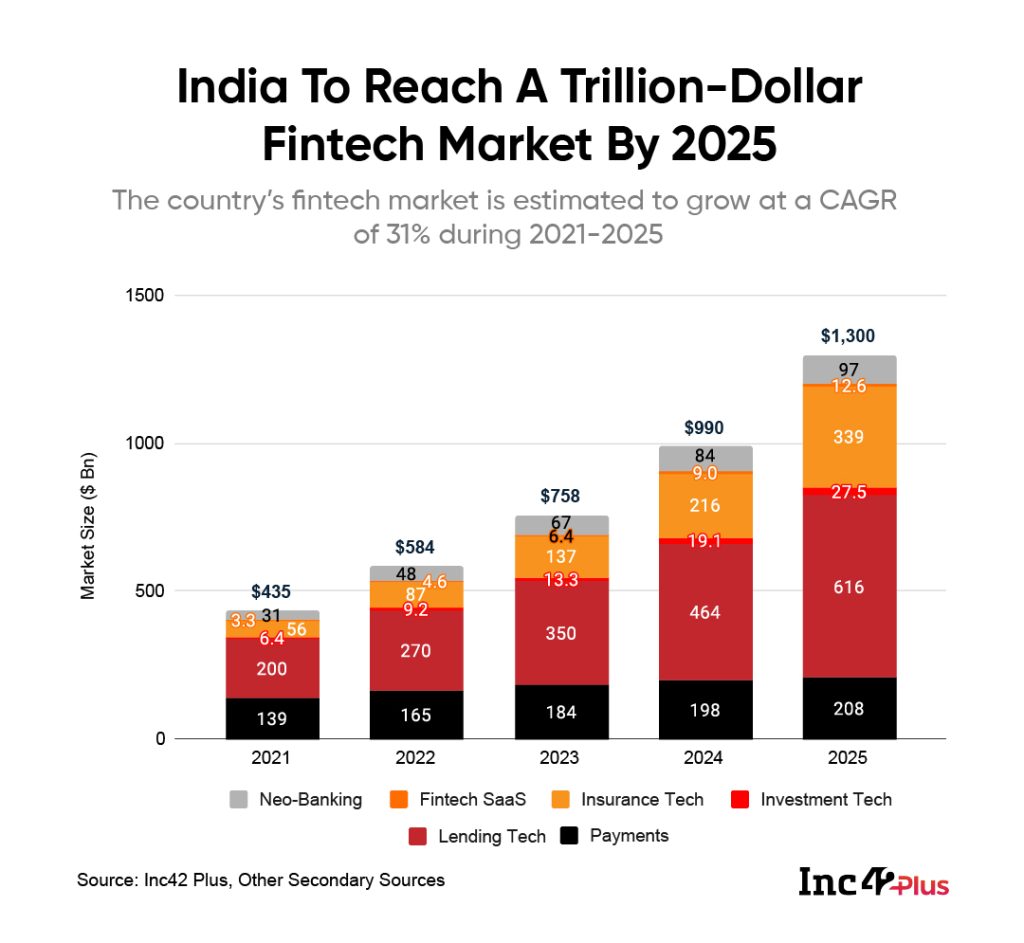CONTENTS
- Drones can Revolutionise the Agriculture Sector
- The Rise in Digital Banking: Fintech Trends in 2024
Drones can Revolutionise the Agriculture Sector
Context:
The utilization of drones has the potential to transform the agricultural sector. The government’s focus on precision agriculture indicates that drones are on the verge of becoming a crucial element in farming practices. In Punjab, where drones were previously associated with illicit activities along the border, there is now a shift towards leveraging them to revolutionize agriculture.
Relevance:
GS3- E-technology in the aid of farmers
Mains Question:
The utilization of drones has the potential to transform the agricultural sector. Comment critically. (10 Marks, 150 Words).
Government Initiatives in This Regard:
- These Unmanned Aerial Vehicles (UAVs) represent a cutting-edge solution for enhancing agriculture’s efficiency, sustainability, and profitability. To empower rural women through Self Help Groups (SHGs), the government launched the ‘Namo Drone Didi’ Scheme in December last year, allocating Rs.1261 Crore for the period from 2024-25 to 2025-26. The scheme aims to equip and train at least 15,000 women SHGs.
- In terms of market potential, a high-end drone capable of multiple tasks costs around Rs 15 lakh. However, government-subsidized schemes offering subsidies of Rs 4-8 lakh on each drone, along with a 3% interest subvention on loans, are expected to significantly impact the Indian agriculture drone market. The market is projected to grow at an annual average rate of over 25% from 2024 to 2028.
- The Government of India (GOI) has exempted agricultural income from taxation. Additionally, in an effort to stimulate the agricultural economy, subsidies are granted for various aspects including fertilizers, irrigation, power, exports, credit, agricultural equipment, and infrastructure.
- The GOI is actively involved in advancing the use of technology in agriculture. In the first quarter of the fiscal year 2022, the GOI updated regulations related to the utilization of agricultural drones.
- A certification scheme for drones, promoting their use in agriculture spraying, was introduced by the GOI. It provided a 100% subsidy or INR 1 million to entities such as Farm Machinery Training Institutes, Krishi Vigyan Kendra, Central Island Agricultural Research Institute, and agricultural universities.
- Moreover, a contingency fund of INR 6,000 per hectare was allocated to facilitate the acquisition of drones from custom hiring centers. This initiative aims to further support the integration of drone technology in agriculture.
The Agricultural Drone Market:
- Globally, the agricultural drone market is anticipated to reach USD 4.7 billion by the end of 2026, with a compound annual growth rate (CAGR) of 31.3% during the forecast period from 2024 to 2026.
- As per certain reports, the utilization of drones in the Indian agricultural sector is projected to experience a Compound Annual Growth Rate (CAGR) of 38.5%, reaching a value of $121.43 million by the year 2030. The rate of adoption for drones is anticipated to constitute 2% of the overall expenditure on agricultural machinery.
- As outlined in a FICCI-EY report, the drone sector has the potential to enhance India’s manufacturing capacity to around $50 billion by the year 2030, leading to the creation of over 500,000 direct and indirect employment opportunities.
- The report further predicts that the drone market in India is expected to achieve a size of $885.7 million by 2021, with agriculture playing a significant role in fueling the demand.

Significance of Drones in Agriculture:
- The adoption of drone technology acts as an advanced decision support system, enabling targeted interventions and minimizing the wastage of crucial resources like water, chemicals, and fertilizers.
- Drones provide high-resolution imagery, offering valuable insights for targeted interventions and preventing unnecessary treatments across entire fields.
- Drones equipped with hyperspectral imaging technology revolutionize crop health monitoring, enabling early detection of pest infestations up to two weeks earlier than traditional methods. This early detection can potentially save up to 30% of the harvest that might otherwise be lost.
- Precision crop management is crucial for balancing agricultural production and environmental preservation. Drones accurately identify areas that require water, allowing farmers to reduce water usage by approximately 25%, promoting sustainable agriculture.
- Efficient field scouting is facilitated by drones, covering vast agricultural areas quickly and providing timely and accurate data. This is particularly valuable for smallholder farmers, allowing them to address potential issues before they become economically damaging.
- Data-driven decision-making is enhanced by the extensive datasets generated by drones, offering insights into crop health, growth patterns, and other variables.
- Farmers can optimize planting densities and nutrient management based on drone-collected data, leading to higher yields and better profits.
- Drones serve as a cost-effective ally in a sector with thin profit margins. Early detection of issues and data-backed decision-making help farmers avoid costly interventions later in the crop cycle.
- Equipped with weather monitoring technology, drones serve as flying weather stations, providing real-time data crucial for planning farm operations and responding to changing weather patterns.
Conclusion:
The government’s increasing focus on precision agriculture suggests that drones are becoming integral to crop cultivation practices. By combining traditional farming expertise with advanced technology, farmers can anticipate a more optimistic and fruitful future. The government’s ability to offset 80% of the drone adoption cost through savings on fertilizer and pesticide subsidies further emphasizes the potential benefits of integrating drone technology into agriculture.
The Rise in Digital Banking: Fintech Trends in 2024
Context:
Fintech is set to revolutionize financial inclusivity, streamline transactions, and reshape interactions between individuals and businesses with financial services. This financial evolution is more than just a transition; it’s a gateway to a new revolution. As we grasp the opportunities and delve deeper into empowering today’s fintech landscape, it becomes evident that another phase of progression is on the horizon.
Relevance:
GS-3
- Capital Market
- IT and Computers
- Cyber Security
- Scientific Innovations and Discoveries
Mains Question:
Fintech can drive financial inclusivity, streamline transactions and redefine the way individuals and businesses interact with financial services. Examine. (15 Marks, 250 Words).
About Financial Technology:
- Financial technology, commonly referred to as Fintech, encompasses innovative technologies aimed at enhancing and automating the delivery and utilization of financial services.
- This term covers any technological advancements within the financial sector, including retail banking, investment services, and even cryptocurrencies such as Decentralized Finance (DeFi), which aims to improve financial literacy and education.
The Importance of Fintech in the Indian Context:
Advancing Financial Inclusion:
A substantial portion of the Indian population remains excluded from the formal financial system, and the adoption of financial technologies can bridge this gap, addressing limitations present in traditional banking and financial models.
Supporting Micro, Small, and Medium Enterprises (MSMEs):
- The existence of MSMEs is often jeopardized by a lack of capital. According to the IFC Report, there is an estimated MSME credit gap of USD 400 billion, and Fintech can play a pivotal role in addressing this challenge, resolving issues related to the availability of credit.
- Various Fintech startups offering simplified and expedited access to loans eliminate the need for MSMEs to navigate through cumbersome documentation, paperwork, and multiple visits to a bank.
Enhanced Customer Experience:
- Fintech startups prioritize delivering convenience, personalization, transparency, accessibility, and user-friendliness to their customers, significantly empowering them.
- The utilization of big data, machine learning, and alternative data for developing credit scores and underwriting credit for customers with limited credit histories is expected to enhance the penetration of financial services in India.
Fintech Trends in the Coming Year:

Embedded Finance Takes Center Stage
- The convergence of finance with non-financial platforms is poised to redefine traditional banking. Embedded finance, the integration of financial services into non-financial platforms, is set for exponential growth.
- Whether it’s e-commerce platforms offering instant credit options or ride-sharing apps facilitating seamless payments, the lines between fintech and other sectors will blur, providing consumers with unparalleled convenience.
- For instance, PaySprint’s API empowers individuals facing physical bank branch challenges, aligning with the trend of meeting customer expectations across various domains.
Decentralized Finance (DeFi) Gains Traction
- The DeFi movement, leveraging blockchain to recreate traditional financial systems without intermediaries, will continue its upward trajectory.
- With promises of transparency, reduced costs, and increased accessibility, DeFi platforms aim to attract a broader user base.
- Fintech companies, focusing on this trend, aim to establish a strong presence through API infrastructure, providing a trusted collaboration platform for the business community with the goal of easy online onboarding and hassle-free processes.
Rise of Digital Identity Solutions
- As digital transactions increase, the need for robust identity verification mechanisms becomes paramount.
- Digital identity solutions, utilizing biometrics, AI, and blockchain, will emerge as a cornerstone for secure and seamless banking experiences.
- These solutions will enhance security protocols and streamline customer onboarding and authentication processes, extending banking and financial services to the remotest areas and catalyzing the Indian Financial Inclusion movement.
AI-driven Personalization
- Artificial Intelligence (AI) will continue reshaping the fintech landscape, particularly in customer experience.
- Advanced AI algorithms will enable banks to provide hyper-personalized services, ranging from tailored financial advice to customized product recommendations. This increased personalization aims to foster stronger customer relationships, driving loyalty and retention.
Sustainable Finance
- With a global emphasis on sustainability, green finance will rise to the forefront of fintech innovations.
- Fintech platforms will integrate ESG (Environmental, Social, and Governance) metrics, providing users insights into the sustainability credentials of their investments and spending patterns.
- Additionally, there will be a surge in fintech solutions specifically designed for financing renewable energy and conservation projects.
Evolution of Central Bank Digital Currencies (CBDCs)
The exploration and potential issuance of CBDCs by central banks will be a pivotal development. CBDCs, digital representations of fiat currencies, have the potential to streamline cross-border transactions, enhance monetary policy effectiveness, and foster financial inclusion.
Challenges in the Fintech Industry:
Cybersecurity Threats:
- Fintech systems face susceptibility to cyber-attacks due to the automation of processes and digitization of data.
- Recent incidents involving debit card companies and banks underscore the vulnerability of Fintech systems, demonstrating the ease with which hackers can infiltrate and cause irreparable damage.
Regulatory Complexities:
- Regulatory challenges pose issues in the evolving landscape of Fintech, especially in the realm of cryptocurrencies.
- The Indian government is adopting a cautious approach toward cryptocurrencies, lacking a regulatory authority, thereby increasing the risk of fraud, threatening investor protection, and impacting the flow of money in the economy.
- The diverse offerings within the Fintech sector make it challenging to devise a single comprehensive approach to address these problems.
Financial Illiteracy:
The lack of financial literacy is a prevalent concern. Only 27% of Indian adults, and 24% of women, meet the minimum level of financial literacy as defined by the Reserve Bank of India.
Illegal Digital Lending:
- The popularity of digital lending through mobile apps during the pandemic brought about various problems.
- More than half of these digital loan providers were found to be operating illegally, exploiting the widespread lack of financial literacy and charging exorbitant interest rates, some as high as 500%.
Conclusion:
Besides implementing technological safeguards, educating and training customers will democratize Fintech and serve as a defense against cyberattacks. Transparency and robust regulation will fortify the Fintech sector and contribute to the potential growth of the Indian economy. A constructive approach recognizing the role Fintech plays in financial inclusion is crucial, setting clear financial targets while providing flexibility for Fintechs to innovate.





